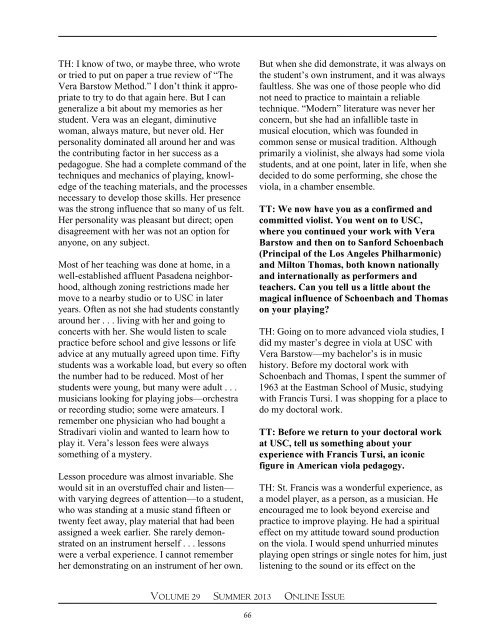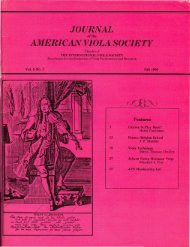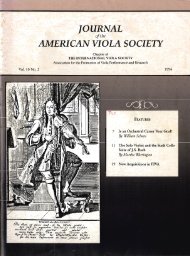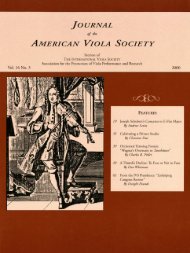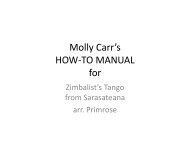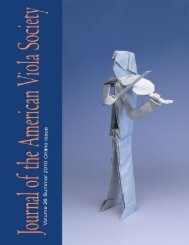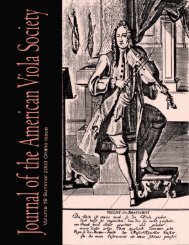Summer 2013 - The American Viola Society
Summer 2013 - The American Viola Society
Summer 2013 - The American Viola Society
Create successful ePaper yourself
Turn your PDF publications into a flip-book with our unique Google optimized e-Paper software.
TH: I know of two, or maybe three, who wrote<br />
or tried to put on paper a true review of “<strong>The</strong><br />
Vera Barstow Method.” I don’t think it appropriate<br />
to try to do that again here. But I can<br />
generalize a bit about my memories as her<br />
student. Vera was an elegant, diminutive<br />
woman, always mature, but never old. Her<br />
personality dominated all around her and was<br />
the contributing factor in her success as a<br />
pedagogue. She had a complete command of the<br />
techniques and mechanics of playing, knowledge<br />
of the teaching materials, and the processes<br />
necessary to develop those skills. Her presence<br />
was the strong influence that so many of us felt.<br />
Her personality was pleasant but direct; open<br />
disagreement with her was not an option for<br />
anyone, on any subject.<br />
Most of her teaching was done at home, in a<br />
well-established affluent Pasadena neighborhood,<br />
although zoning restrictions made her<br />
move to a nearby studio or to USC in later<br />
years. Often as not she had students constantly<br />
around her . . . living with her and going to<br />
concerts with her. She would listen to scale<br />
practice before school and give lessons or life<br />
advice at any mutually agreed upon time. Fifty<br />
students was a workable load, but every so often<br />
the number had to be reduced. Most of her<br />
students were young, but many were adult . . .<br />
musicians looking for playing jobs—orchestra<br />
or recording studio; some were amateurs. I<br />
remember one physician who had bought a<br />
Stradivari violin and wanted to learn how to<br />
play it. Vera’s lesson fees were always<br />
something of a mystery.<br />
Lesson procedure was almost invariable. She<br />
would sit in an overstuffed chair and listen—<br />
with varying degrees of attention—to a student,<br />
who was standing at a music stand fifteen or<br />
twenty feet away, play material that had been<br />
assigned a week earlier. She rarely demonstrated<br />
on an instrument herself . . . lessons<br />
were a verbal experience. I cannot remember<br />
her demonstrating on an instrument of her own.<br />
But when she did demonstrate, it was always on<br />
the student’s own instrument, and it was always<br />
faultless. She was one of those people who did<br />
not need to practice to maintain a reliable<br />
technique. “Modern” literature was never her<br />
concern, but she had an infallible taste in<br />
musical elocution, which was founded in<br />
common sense or musical tradition. Although<br />
primarily a violinist, she always had some viola<br />
students, and at one point, later in life, when she<br />
decided to do some performing, she chose the<br />
viola, in a chamber ensemble.<br />
TT: We now have you as a confirmed and<br />
committed violist. You went on to USC,<br />
where you continued your work with Vera<br />
Barstow and then on to Sanford Schoenbach<br />
(Principal of the Los Angeles Philharmonic)<br />
and Milton Thomas, both known nationally<br />
and internationally as performers and<br />
teachers. Can you tell us a little about the<br />
magical influence of Schoenbach and Thomas<br />
on your playing?<br />
TH: Going on to more advanced viola studies, I<br />
did my master’s degree in viola at USC with<br />
Vera Barstow—my bachelor’s is in music<br />
history. Before my doctoral work with<br />
Schoenbach and Thomas, I spent the summer of<br />
1963 at the Eastman School of Music, studying<br />
with Francis Tursi. I was shopping for a place to<br />
do my doctoral work.<br />
TT: Before we return to your doctoral work<br />
at USC, tell us something about your<br />
experience with Francis Tursi, an iconic<br />
figure in <strong>American</strong> viola pedagogy.<br />
TH: St. Francis was a wonderful experience, as<br />
a model player, as a person, as a musician. He<br />
encouraged me to look beyond exercise and<br />
practice to improve playing. He had a spiritual<br />
effect on my attitude toward sound production<br />
on the viola. I would spend unhurried minutes<br />
playing open strings or single notes for him, just<br />
listening to the sound or its effect on the<br />
VOLUME 29 SUMMER <strong>2013</strong> ONLINE ISSUE<br />
66


